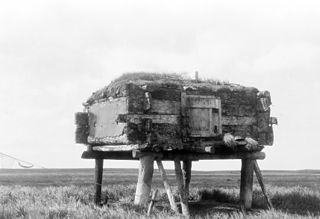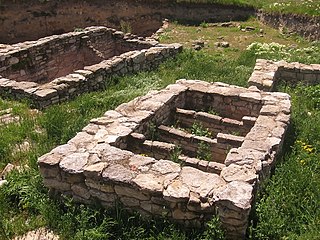
In physics, cryogenics is the production and behaviour of materials at very low temperatures.

Food preservation includes processes that make food more resistant to microorganism growth and slow the oxidation of fats. This slows down the decomposition and rancidification process. Food preservation may also include processes that inhibit visual deterioration, such as the enzymatic browning reaction in apples after they are cut during food preparation. By preserving food, food waste can be reduced, which is an important way to decrease production costs and increase the efficiency of food systems, improve food security and nutrition and contribute towards environmental sustainability. For instance, it can reduce the environmental impact of food production.
Cryobiology is the branch of biology that studies the effects of low temperatures on living things within Earth's cryosphere or in science. The word cryobiology is derived from the Greek words κρῧος [kryos], "cold", βίος [bios], "life", and λόγος [logos], "word". In practice, cryobiology is the study of biological material or systems at temperatures below normal. Materials or systems studied may include proteins, cells, tissues, organs, or whole organisms. Temperatures may range from moderately hypothermic conditions to cryogenic temperatures.

Food storage is a way of decreasing the variability of the food supply in the face of natural, inevitable variability. It allows food to be eaten for some time after harvest rather than solely immediately. It is both a traditional domestic skill and, in the form of food logistics, an important industrial and commercial activity. Food preservation, storage, and transport, including timely delivery to consumers, are important to food security, especially for the majority of people throughout the world who rely on others to produce their food.

Liquid nitrogen—LN2—is nitrogen in a liquid state at low temperature. Liquid nitrogen has a boiling point of about −196 °C (−321 °F; 77 K). It is produced industrially by fractional distillation of liquid air. It is a colorless, mobile liquid whose viscosity is about one tenth that of acetone (i.e. roughly one thirtieth that of room temperature water). Liquid nitrogen is widely used as a coolant.

Freezing food preserves it from the time it is prepared to the time it is eaten. Since early times, farmers, fishermen, and trappers have preserved grains and produce in unheated buildings during the winter season. Freezing food slows decomposition by turning residual moisture into ice, inhibiting the growth of most bacterial species. In the food commodity industry, there are two processes: mechanical and cryogenic. The freezing kinetics is important to preserve the food quality and texture. Quicker freezing generates smaller ice crystals and maintains cellular structure. Cryogenic freezing is the quickest freezing technology available due to the ultra low liquid nitrogen temperature −196 °C (−320 °F).

A frozen meal, prepackaged meal, ready-made meal, ready meal (UK), frozen dinner, and microwave meal is ultra-processed food portioned for an individual. A frozen meal in the United States and Canada usually consists of a type of meat, fish, or pasta for the main course, and sometimes vegetables, potatoes, and/or a dessert. Some frozen meals feature Indian, Chinese, Mexican, and other foods of international customs. Another form of convenience food, which is merely a refrigerated ready meal that requires less heating but expires sooner, is popular.

Blanching is a cooking process in which a food, usually a vegetable or fruit, is scalded in boiling water, removed after a brief timed interval, and finally plunged into iced water or placed under cold running water to halt the cooking process. Blanching foods helps reduce quality loss over time. Blanching is often used as a treatment prior to freezing, dehydrating, or canning vegetables or fruits to deactivate enzymes, modify texture, remove the peel and wilt tissue. The inactivation of enzymes preserves colour, flavour, and nutritional value. The process has three stages: preheating, blanching, and cooling. The most common blanching methods for vegetables/fruits are hot water and steam, while cooling is either done using cold water or cool air. Other benefits of blanching include removing pesticide residues and decreasing microbial load. Drawbacks to the blanching process can include leaching of water-soluble and heat-sensitive nutrients and the production of effluent.

Freeze drying, also known as lyophilization or cryodesiccation, is a low temperature dehydration process that involves freezing the product and lowering pressure, thereby removing the ice by sublimation. This is in contrast to dehydration by most conventional methods that evaporate water using heat.

Sous vide, also known as low-temperature, long-time (LTLT) cooking, is a method of cooking invented by the French chef Georges Pralus in 1974, in which food is placed in a plastic pouch or a glass jar and cooked in a water bath for longer than usual cooking times at a precisely regulated temperature.

The following outline is provided as an overview of and topical guide to the preparation of food:

Blast chilling is a method of cooling food quickly to a low temperature that is relatively safe from bacterial growth. Bacteria multiply fastest between +8 and +68 °C. By reducing the temperature of cooked food from +70 to +3 °C or below within 90 minutes, the food is rendered safe for storage and later consumption. This method of preserving food is commonly used in food catering and, recently, in the preparation of "instant" foods, as it ensures the safety and the quality of the food product.

The term fish processing refers to the processes associated with fish and fish products between the time fish are caught or harvested, and the time the final product is delivered to the customer. Although the term refers specifically to fish, in practice it is extended to cover any aquatic organisms harvested for commercial purposes, whether caught in wild fisheries or harvested from aquaculture or fish farming.

Fish preservation is the method of increasing the shelf life of fish and other fish products by applying the principles of different branches of science in order to keep the fish, after it has landed, in a condition wholesome and fit for human consumption. Ancient methods of preserving fish included drying, salting, pickling and smoking. All of these techniques are still used today but the more modern techniques of freezing and canning have taken on a large importance.
Cryofixation is a technique for fixation or stabilisation of biological materials as the first step in specimen preparation for the electron microscopy and cryo-electron microscopy. Typical specimens for cryofixation include small samples of plant or animal tissue, cell suspensions of microorganisms or cultured cells, suspensions of viruses or virus capsids and samples of purified macromolecules, especially proteins.

Cryopreservation or cryoconservation is a process where biological material - cells, tissues, or organs - are frozen to preserve the material for an extended period of time. At low temperatures any cell metabolism which might cause damage to the biological material in question is effectively stopped. Cryopreservation is an effective way to transport biological samples over long distances, store samples for prolonged periods of time, and create a bank of samples for users. Molecules, referred to as cryoprotective agents (CPAs), are added to reduce the osmotic shock and physical stresses cells undergo in the freezing process. Some cryoprotective agents used in research are inspired by plants and animals in nature that have unique cold tolerance to survive harsh winters, including: trees, wood frogs, and tardigrades.

Ice storage air conditioning is the process of using ice for thermal energy storage. The process can reduce energy used for cooling during times of peak electrical demand. Alternative power sources such as solar can also use the technology to store energy for later use. This is practical because of water's large heat of fusion: one metric ton of water can store 334 megajoules (MJ) of energy, equivalent to 93 kWh.
A cell bank is a facility that stores cells of specific genome for the purpose of future use in a product or medicinal needs, but can also describe the entity of stored cells itself. Cell banks often contain expansive amounts of base cell material that can be utilized for various projects. Cell banks can be used to generate detailed characterizations of cell lines and can also help mitigate cross-contamination of a cell line. Utilizing cell banks also reduces the cost of cell culture processes, providing a cost-efficient alternative to keeping cells in culture constantly. Cell banks are commonly used within fields including stem cell research and pharmaceuticals, with cryopreservation being the traditional method of keeping cellular material intact. Cell banks also effectively reduce the frequency of a cell sample diversifying from natural cell divisions over time.
Food and biological process engineering is a discipline concerned with applying principles of engineering to the fields of food production and distribution and biology. It is a broad field, with workers fulfilling a variety of roles ranging from design of food processing equipment to genetic modification of organisms. In some respects it is a combined field, drawing from the disciplines of food science and biological engineering to improve the earth's food supply.













